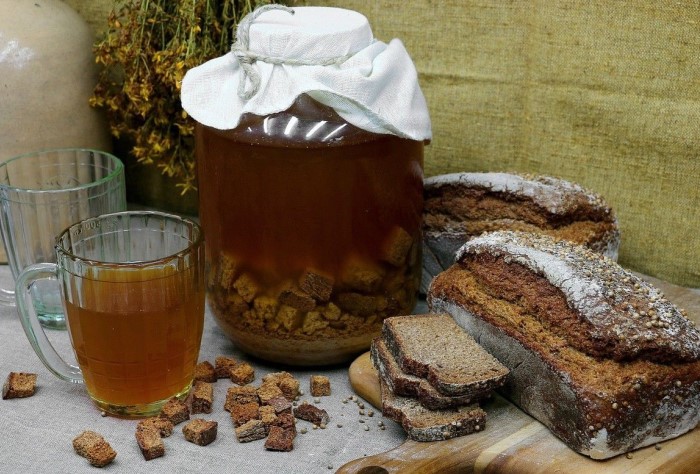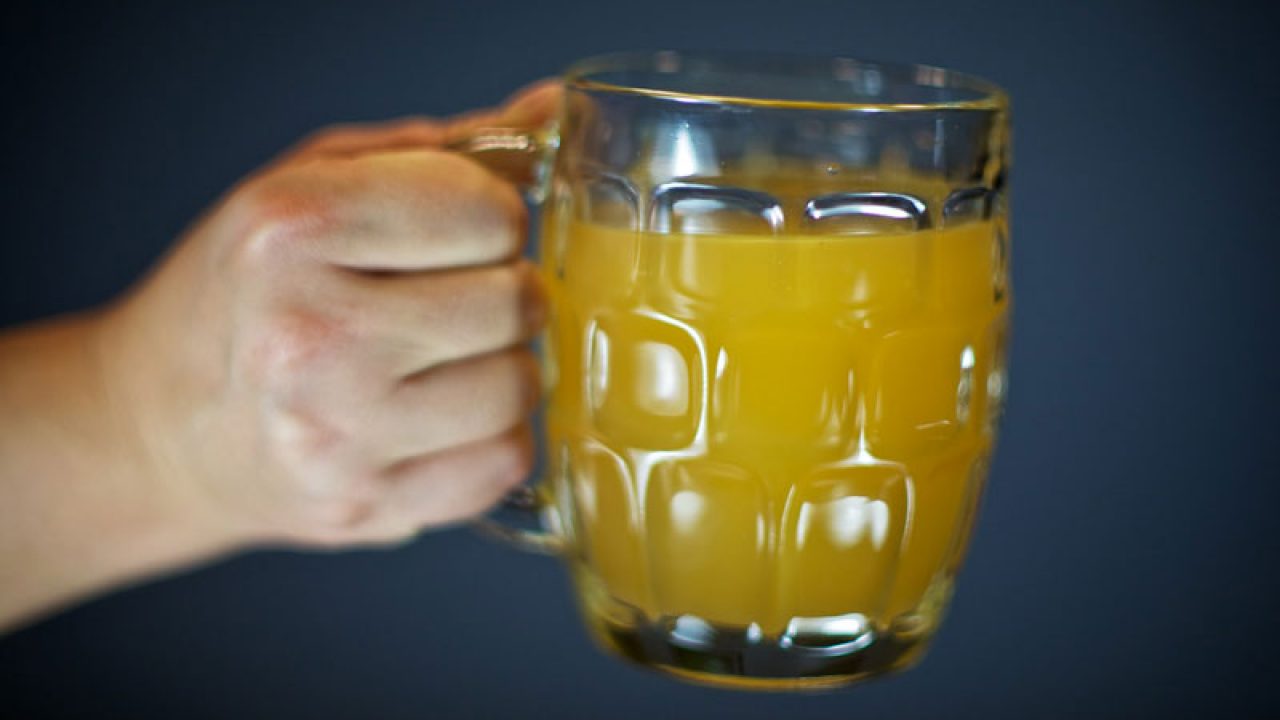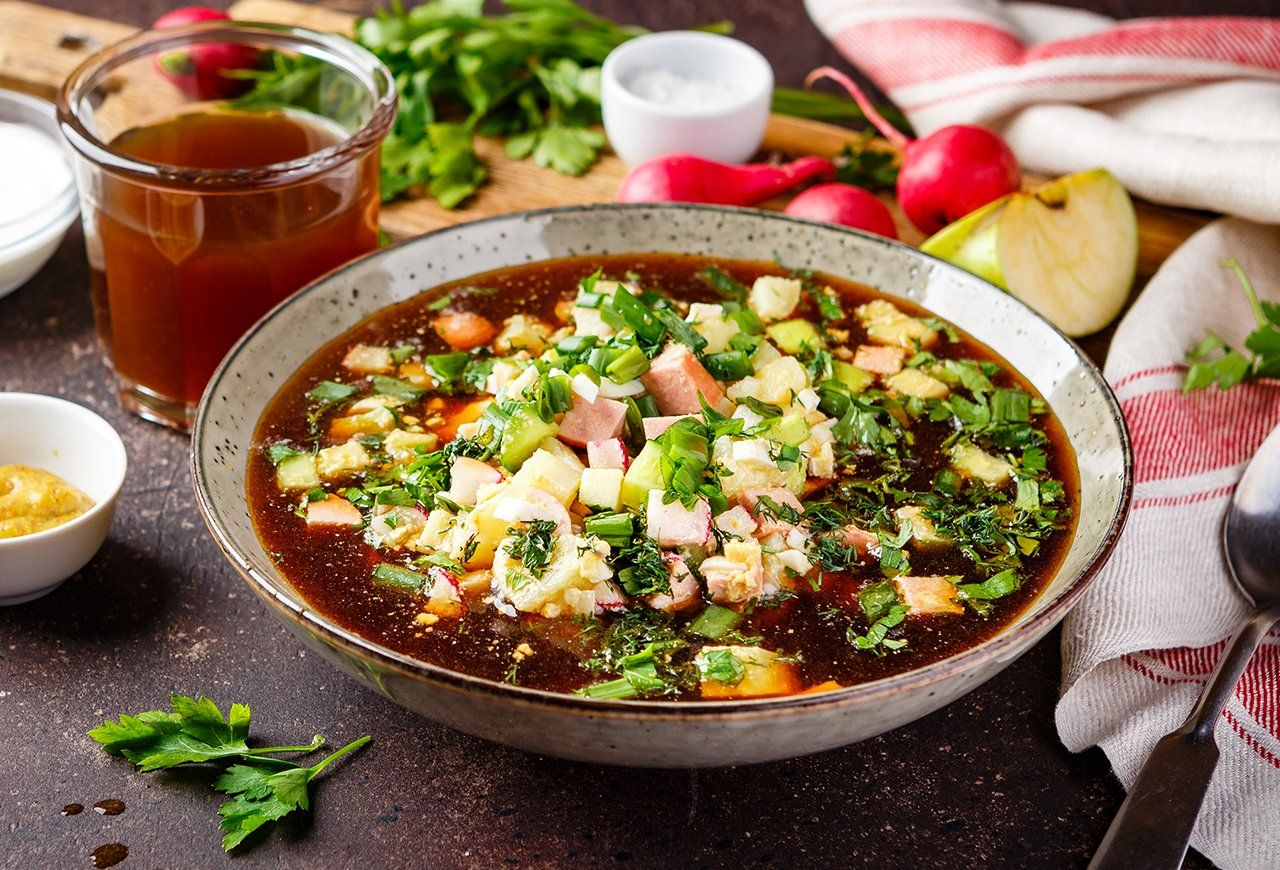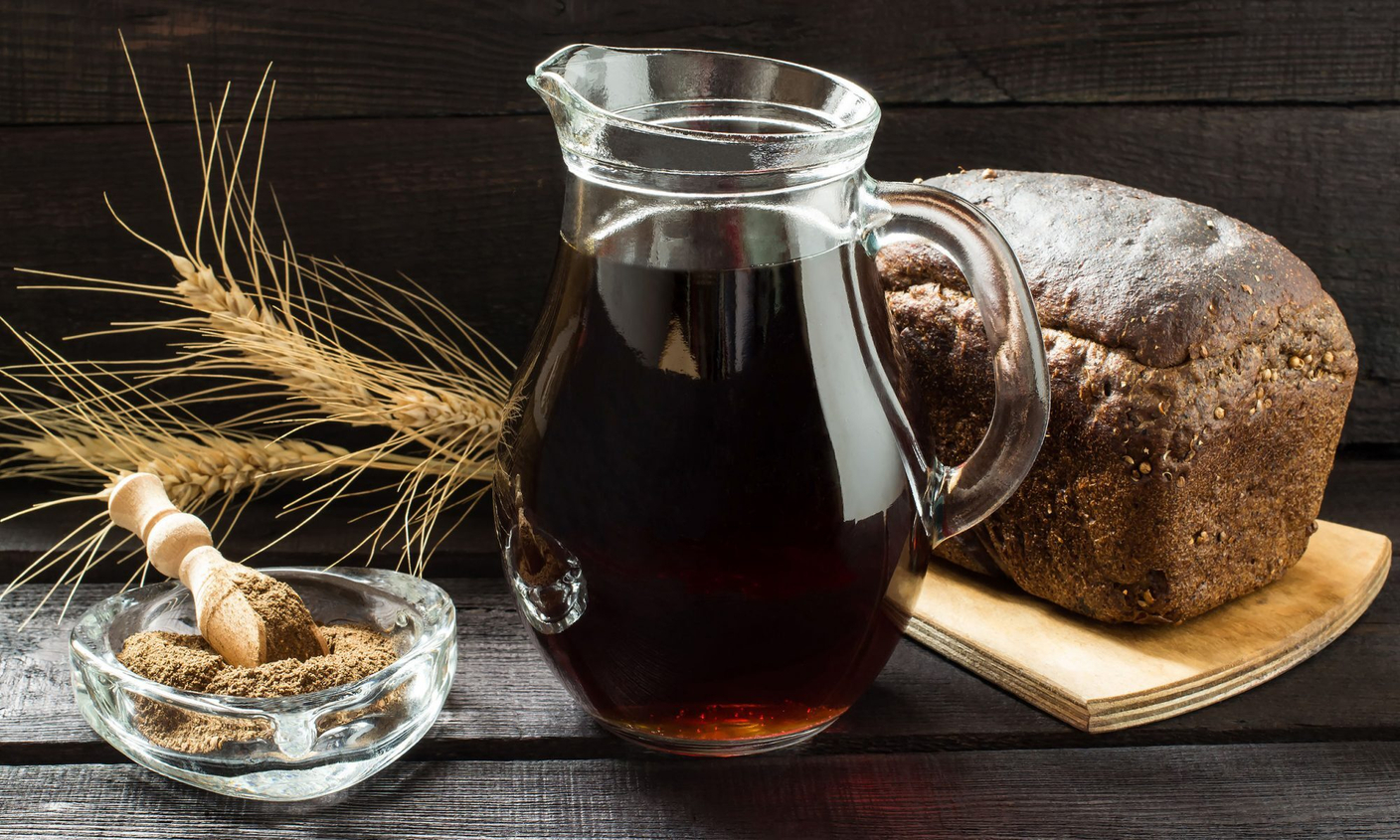Kvass: types, labels, serving, and recipes – the complete guide from Berezka
Kvass is a non-alcoholic fermented drink made from grain-based raw materials—typically rye and/or barley, in the form of rye bread and malt—to which water and a moderate amount of sugar or molasses are added. Fermentation is intentionally incomplete and led by yeasts (which produce CO₂ and trace alcohol) and often lactic-acid bacteria, which lend a gentle tang and round out the flavor. Beyond the classic base, the method allows small tweaks: adding sugar or syrup to feed fermentation and balance the profile, sometimes honey for aromatic roundness; modern or regional versions may also include flavorings such as cherry, mint, or berries. When shopping, it helps to distinguish authentic kvass from non-alcoholic “kvass-flavored” soft drinks, which don’t follow the same logic of composition. In its unpasteurized (“live”) form, part of the microbiota remains active, which means a shorter shelf life and the need for refrigeration; pasteurized versions are more shelf-stable, with the flora halted. In the glass, kvass is a refreshing drink with gentle effervescence, hints of toasted bread and malt, and a discreet acidity that keeps it lively.
Although classified as non-alcoholic, fermentation does produce a very small residual alcohol content (within legal limits). In practice many commercial products come in extremely low, so for children and pregnant women the advice is to choose pasteurized versions and serve in small portions.

Kvass is deeply rooted in the food culture of Eastern Europe (Russia, Ukraine, Belarus, the Baltic states) and is attested as far back as the late 10th century in chronicles of Kievan Rus’. It long remained a day-to-day household drink—especially in summer—and the classic base for cold soups like okroshka. Later centuries brought written recipes in household manuals (for example, Domostroi, 16th c.); in the second half of the 19th century kvass entered commercial circulation, with dozens—and even more than a hundred—varieties recorded (mint, cherry, lemon, raspberry), and factories in the Baltic governorates were already producing at industrial scale. The 20th century fixed its urban image: those towed yellow tanks—mobile street dispensers—became a symbol of summer in many post-Soviet cities. After the 1990s, as sanitary-technical rules changed, street barrel sales shrank and bottling took over, without pushing kvass out of home kitchens. The broader region also has local names for kvass-type drinks: Lithuanian gira, Estonian kali, Polish kwas chlebowy—evidence of deep roots, with recipes adapted to the bread, malt, and water available in each place.
Types of kvass
Kvass comes in two main technological families—unpasteurized (“live”) and pasteurized—and three visual states: unfiltered, unclarified; unfiltered, clarified; and filtered. These aren’t just technicalities: they change how the drink looks in the glass, how it must be stored, and especially how it tastes. Below we sort things in plain terms and anchor explanations in Berezka’s range so you can choose quickly.

Unpasteurized kvass is the closest to home tradition: the fermenting flora remains active and the drink continues to evolve slowly even after bottling. Labels will say “unpasteurized,” often alongside “unfiltered”; shelf life is shorter and cold storage is a must. In the glass, the liquid appears slightly hazy and may leave a small deposit at the bottom of the bottle—a normal sign with unfiltered, unclarified styles. The taste is more complex: bread-and-malt notes, a fine lactic tang, and a very pleasant natural fizz.
The pasteurized version wins for convenience: heat treatment stops the fermenting flora, ensuring a longer shelf life and a stable flavor from batch to batch. It’s the ideal option to buy by the case, for events or picnics, or simply if you want an everyday drink that’s predictable and easy to find in multiple formats (0.5–2 L). The aroma profile remains appealing, with bread accents and well-measured effervescence; compared with “live” styles, the “lively” nuances are gently toned down.
In broad terms there are three categories of kvass:
- “Black” kvass: deep amber to brown color; aromas of toasted bread crust, malt, and discreet caramel/molasses touches. Excellent with picnic foods, hot dogs, savory pies, or grilled meats, and best served well chilled. If you like a lightly sweet drink, turn it into a “kvass radler” by mixing it with lemonade or 0.0 beer. In Berezka’s lineup you’ll find representative options such as Kvas Taras NEGRU 500 ml, Cvas Taras negru 1.5 L, or Cvas Lidskii negru 1.5 L.
- “Classic” (amber) kvass: amber-brown color, moderate sweetness, balanced acidity, and a malt profile less caramelized than the “black” style but rounder than the “white.” This is the everyday classic—great on its own and with convenient lunch foods or picnic snacks. In Berezka’s selection this includes Kvas Taras 500 ml (green can, classic), Cvas Taras 2 L (classic), Cvas Lidskii natural cereal 1.5 L, and Afanasii Old Monastery Kvass 1 L.
- “White” kvass: straw-gold to beige; light head; a lean body and sprightly acidity that makes it ideal for okroshka and “spritz”-type mixes. It has fewer caramelized accents than the “black” style, with an overall impression of brisk freshness. Serve very cold, even over ice; for a drier feel, dilute 2:1 with sparkling water or add a lemon slice. In Berezka’s range, choose Kvas Taras ALB 500 ml, Cvas Taras alb nefiltrat 1.5 L, and various White Kvas options depending on stock.

Berezka’s offer is built around the classic “black” and “white” styles. If you want a flavored direction (berries, ginger, citrus, etc.), consider kombucha-type fermented drinks: they have a pleasant tonic acidity, come in many flavors, and work well in light mixes—including as a gluten-free option.
Nutritional benefits
Kvass is, first and foremost, a refreshing fermented beverage. It isn’t a medicine and doesn’t promise miracles; its value lies in freshness, in the fermentation-built aroma profile, and sometimes in the presence of live microflora. When deciding whether it “does you good,” start with the label, how you serve it, and your own dietary needs.
Nutritionally, kvass provides water and easily fermentable carbohydrates, along with a small amount of fermentation-derived compounds (organic acids, esters that give “bread” aromas). 100 ml of kvass provides ~30–40 kcal and ~6–7 g sugar. Consequently, a 500 ml serving means about 150–200 kcal and 30–35 g sugar. Grain raw materials contribute traces of B-vitamins and minerals (especially in unfiltered versions), and “unpasteurized” types may contain yeast cells and lactic-acid bacteria—a natural probiotic, but don’t overstate it: kvass isn’t a supplement, and the effective dose depends on why you’re drinking it.
After opening, consume within 1–3 days, per the label; for unpasteurized types, keep them away from heat to avoid accelerating fermentation.
Classic kvass starts from gluten-containing grains (rye/barley), so it’s not suitable for those with celiac disease or gluten intolerance. If you’re sensitive to yeast or to carbonated/acidic drinks, test small amounts or choose alternatives like kombucha (note: it may contain trace caffeine from tea).
Kvass vs. kombucha vs. soft drinks
Berezka carries all three directions—kvass, kombucha, juices, and carbonated soft drinks—and they differ by acidity, sweetness, and presence or absence of caffeine.
Kvass remains the “bread” drink: rounded, with gentle fizz and a discreet tang. In practice it sits between kombucha (usually “drier”) and classic sodas (generally sweeter). Choose it when you want something salty-food-friendly for picnics, hot dogs, or savory pies, and when you prefer a traditional alternative to soda.
Kombucha plays in a tonic register: a tea-based fermentation (SCOBY) with lively acidity and, depending on the recipe, less sugar than kvass—and far less than standard cola. Some varieties retain a little caffeine (from tea). The flavor palette is wide—ginger, berries, citrus. It’s a natural choice if you prefer a lighter, gluten-free drink that’s good at lunch for hydrating with a fresh edge. In the shop, look for our ready-to-drink kombucha lines and pick flavors by pairing: ginger with Asian dishes; red fruits with salads or simple desserts.
Juices (100% or nectars) lean into natural sweetness and lack of CO₂. A 100% juice gives full fruit flavor but naturally contains substantial sugar; nectars may include added sugar or a lower fruit-pulp fraction—always check the fruit content percentage. Choose them for breakfast, mocktails (kvass + apple juice is a classic), or for kids when you want no fizz and no caffeine. At Berezka you’ll find apple, sour cherry, orange, and seasonal blends—also useful as a base to mix with kvass when you want a rounder profile.
Carbonated soft drinks (cola, lemonade, tonics) are about consistent flavor and immediate effect: firm foam, clear aromatics, sometimes caffeine (cola, tonic), and generally more sugar than kvass or kombucha.
If you’re aiming for less sugar, remember the simple rule of thumb: kombucha ≲ kvass ≪ cola (on average), and any drink can be “lightened” with sparkling water 1:1 in the glass.
How to serve kvass
Kvass shows best when properly chilled and poured with a little care. For the white style, aim for 4–6 °C; for brown and black, 6–8 °C keeps malt aromas open without making the fizz aggressive.
If you have unfiltered, especially unclarified kvass, roll the bottle gently on the table for a few seconds to lift the fine lees without over-turbidizing the liquid. Open carefully and pour in a thin stream down the inside of the glass; for a perfectly clear pour, leave the last centimeter in the bottle. If you enjoy a fuller texture, give a discreet swirl at the end and pour the remainder over the glass.
For a drier profile, combine kvass with sparkling water: 2:1 (kvass:water) preserves its character, 1:1 turns it into an ultra-refreshing spritz. A lemon slice brightens “black” styles without spoiling them, while the “white” style takes well to a twist of lemon peel or a mint leaf lightly bruised between your fingers. For a beer-like non-alcoholic feel, turn a black kvass into a “radler”: two parts kvass to one part lemonade or 0.0 beer—you’ll keep the bread aromas and gain a playful vibe. If you want fruity roundness, kvass + apple juice in equal parts remains a sure bet, especially with “white” and “brown” styles.
Did you know you can make a traditional soup with kvass? It’s called okroshka—cooling, satisfying, perfect for summer.
Serves 6–8: Chill 1.5 L kvass (ideally white, not too sweet). Dice 4 boiled potatoes, 4 hard-boiled eggs, 300–400 g boiled meat or doctor-style bologna, 3–4 cucumbers, a bunch of radishes, scallions, and dill. Separately mix 250 g cultured sour cream with 1–2 tsp mustard and a cup of kvass to make a binding “sauce.” In a bowl combine the solids, pour in cold kvass to cover, add the sauce, and salt to taste; for extra brightness, a few drops of lemon juice balance perfectly. Chill 15–20 minutes before serving to let flavors meld. Variations with kefir + kvass (1:1) are richer and keep you fuller in hot weather.

Frequently asked questions
- Is sediment in the bottle normal?
Yes, if it’s unfiltered, unclarified. Clarified or filtered versions should pour clear.
- Why does it foam when opened?
Because of CO₂ formed during fermentation and/or added at bottling. Chill well and open slowly over the glass.
- Is it suitable for children?
Choose pasteurized and serve in small portions.
- Does it contain gluten?
Yes, in classic rye/barley-based versions. If you have restrictions, look for gluten-free alternatives (e.g., certain kombuchas).
- How should I store it?
Cold and out of direct sun. Unpasteurized has a shorter shelf life and needs the cold chain; after opening, follow the producer’s guidance (generally 1–3 days).
- Which one to choose for okroshka?
A less-sweet white kvass, well chilled.
- “Black,” “classic,” “white”—what’s the short version?
“Black” is maltier and lightly caramelized; “brown/classic” is balanced, everyday; “white” is lighter and more spritzy.
- Can I mix it with beer?
You can make a kvass “radler” with beer or lemonade; if you use alcoholic beer, remember the result is no longer “non-alcoholic.”
Does it pair with desserts?
Yes—especially black kvass, well chilled, with dry desserts (pound cake, biscuits). For very sweet pastries, dilute the kvass or choose a drier style.
Kvass is an honest alternative to soda: a fermented, refreshing drink with the personality of bread and malt. Pick your style for the occasion—white for okroshka and spritzes, brown for day-to-day, black for hearty food—check the label for sugar and processing, and serve it ice-cold. The rest is easy: find your match in our range and enjoy the glass.
Explore Berezka’s selection— kvass , kombucha, juices, and soft drinks—and choose what fits you today.



 București
București
























